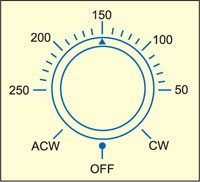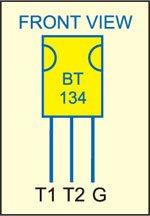 Measure AC mains voltage without using a multimeter. All you need to do is to slightly modify the light dimmer fitted at the base of a table lamp for use as a voltmeter. When the dimmer is turned anticlockwise to a point where the filament glow is just visible, that point can be used as the reference point for measuring the voltage.
Measure AC mains voltage without using a multimeter. All you need to do is to slightly modify the light dimmer fitted at the base of a table lamp for use as a voltmeter. When the dimmer is turned anticlockwise to a point where the filament glow is just visible, that point can be used as the reference point for measuring the voltage.
Light dimmer circuit

First, remove the old knob and fix a circular white paper around the shaft. Now put back a skirted knob with a cursor as close to the paper as possible and mark two extremities of the pot on the paper as CW and ACW (see Fig. 2).

Circuit operation
Switch on the lamp via a variac and feed 50 volts. Rotate the potmeter knob anticlockwise until the filament glow is just visible and mark that point against the cursor as 50V. Keep on increasing the voltage to 100, 150, 180, 200 and 220 using the variac and calibrating the scale for all the voltages. Now a voltage scale is created. The only snag is that the voltage is increasing in anti-clock-wise direction, which should not be a problem. The scale will not however be linear unlike the one shown in the sketch. Accuracy will depend on the calibration standard used and the tolerance is of the order of 1 percent ±5 volts. The diameter of the knob of potmeter and fineness of cursor can be of help in getting better accuracy and tolerance.

An ordinary fan regulator can be used with a lamp of 40, 60 or 100 watts and calibrated accordingly. The minimum measurable voltage is naturally limited to the one required for ‘just visible’ condition. With R1 open circuited the maximum scale voltage will be around 220 volts.
The article was first published in August 2005 and has recently been updated.









